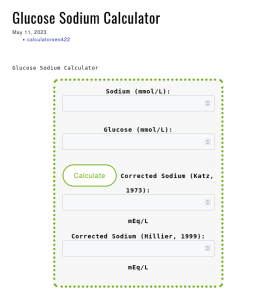Glucose Sodium Calculator
Glucose Sodium Calculator
What is Glucose Sodium Calculator?
Glucose Sodium Calculator is a tool that helps to estimate the corrected sodium level in the blood based on the serum glucose level. This calculator is used in the medical field, particularly in the management of patients with conditions such as diabetes, hyponatremia, and hypernatremia.
The corrected sodium level is important because it provides a more accurate measure of the body’s electrolyte balance than the measured sodium level alone. The measured sodium level can be affected by changes in serum glucose level, so correcting for this can help healthcare professionals make better clinical decisions.
Formula for Glucose Sodium Calculator:
There are two formulas used in the Glucose Sodium Calculator: Katz (1973) and Hillier (1999).
The Katz (1973) formula is as follows:
Corrected Sodium (Katz, 1973) = Measured sodium + 0.016 * (Serum glucose – 100)
The Hillier (1999) formula is as follows:
Corrected Sodium (Hillier, 1999) = Measured sodium + 0.024 * (Serum glucose – 100)
In both formulas, the serum glucose level must be in mg/dL for the calculation to work.
Example:
Suppose a patient has a measured sodium level of 140 mmol/L and a serum glucose level of 200 mg/dL. Using the Katz formula, we can estimate the corrected sodium level as follows:
Corrected Sodium (Katz, 1973) = 140 + 0.016 * (200 – 100) = 142.2 mEq/L
Similarly, using the Hillier formula, we can estimate the corrected sodium level as follows:
Corrected Sodium (Hillier, 1999) = 140 + 0.024 * (200 – 100) = 143.6 mEq/L
Brief History:
The Glucose Sodium Calculator was first introduced by Katz in 1973 as a way to estimate the corrected sodium level in patients with hyperglycemia. The Katz formula was later modified by Hillier in 1999 to include a higher correction factor for glucose, which is now commonly used in clinical practice.
Since then, the Glucose Sodium Calculator has become a standard tool in the management of patients with diabetes, hyponatremia, and hypernatremia.
It has also been incorporated into electronic medical records and clinical decision support systems to help healthcare professionals make more accurate and timely clinical decisions.
FAQs:
What is hyponatremia and how does the Glucose Sodium Calculator help manage it?
Hyponatremia is a condition in which the sodium level in the blood is too low. It can be caused by a number of factors, including excessive fluid intake, certain medications, and certain medical conditions. The Glucose Sodium Calculator helps manage hyponatremia by providing a more accurate estimate of the corrected sodium level, which can help healthcare professionals determine the best course of treatment.
Why is it important to correct for serum glucose when measuring sodium levels?
The serum glucose level can affect the measured sodium level because glucose can pull water out of cells and into the bloodstream, diluting the sodium concentration. Correcting for serum glucose can help provide a more accurate measure of the body’s electrolyte balance and avoid misdiagnosis and inappropriate treatments.
Are there any limitations to the Glucose Sodium Calculator?
The Glucose Sodium Calculator has some limitations. It assumes that the patient has a normal water balance and normal renal function. It also assumes that the measured sodium level is accurate and that there are no other factors affecting the serum glucose level. Finally, the formula may not be accurate in patients with extreme hyperglycemia or extreme hyponatremia, and it should be used.

